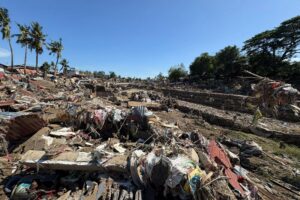Marcos Jr. Invokes Emergency Powers to Fast-Track Tino Recovery While Manila Braces for New Storm

MANILA, Philippines — The Philippines is grappling with a severe, dual-pronged weather crisis, compelling President Ferdinand Marcos Jr. to declare a sweeping State of National Calamity for a period of one year. This decisive executive action, formalized under Proclamation No. 1077 on November 5, aims to aggressively accelerate the nationwide relief, recovery, and rehabilitation efforts following the widespread devastation left by Typhoon Tino (international name: Kalmaegi) while simultaneously preparing the nation for the imminent threat of Super Typhoon Uwan (Fung-wong).
The proclamation grants the government essential emergency powers to manage the catastrophe’s aftermath efficiently and responsibly.
💰 Unleashing Emergency Funds and Protecting Consumers
By declaring a one-year State of National Calamity, President Marcos Jr. immediately unlocked critical mechanisms to support the hard-hit regions spanning Visayas, Mindanao, and Southern Luzon.
Financial Mobilization: Proclamation No. 1077 authorizes the national and local governments to release and utilize appropriate funds, including the vital Calamity and Quick Response Funds, for immediate rescue, recovery, and rehabilitation programs. This streamlined financial access is crucial for the timely delivery of aid to the people affected and displaced by Tino.
Economic Safeguards: The declaration automatically triggers the imposition of a price freeze on basic necessities and prime commodities across the country, a key measure under the Philippine Disaster Risk Reduction and Management Act. This ensures stability in the local markets, preventing opportunism, overpricing, and hoarding amid the crisis.
Direct Aid: In a concrete show of support, the Office of the President (OP) has already approved the release of P760 million in financial assistance to the local government units (LGUs) most battered by Tino, with provinces like Cebu receiving substantial allocations to jumpstart their recovery.
📜 Mandate for Coordinated Response and Restoration
President Marcos Jr. used the proclamation to issue a clear, two-fold directive to all government agencies and instrumentalities:
-
Urgent Disaster Response: Agencies are ordered to “continuously undertake urgent and critical disaster response to save lives, reduce health impacts, ensure public safety and meet the basic subsistence needs of the people affected.”
Post-Disaster Recovery: They are further directed to “implement post-disaster recovery measures to restore normalcy, and improve facilities, livelihood and living conditions of disaster-stricken communities.”
This mandate also emphasizes coordination with and augmentation of basic services for affected LGUs, while facilitating necessary support from the private sector and international assistance. Furthermore, law enforcement agencies, with support from the Armed Forces of the Philippines, are tasked with maintaining peace and order in the affected areas.
The proclamation stressed that the State of National Calamity shall remain in force “unless earlier lifted by the President,” underscoring the long-term commitment required for national rebuilding.
💔 The Scar of Typhoon Tino: Wiped-Out Communities
The devastation left by Typhoon Tino, which has been reported to have killed at least 188 people, is evident in provinces across the central and southern Philippines. Nowhere is the tragedy more stark than in the riverside communities of Talisay City, Cebu.
Riverside settlements like Purok Isla Verde and Sitio Bahala in Talisay City were practically wiped out when the Mananga River overflowed with terrifying speed and volume. Reports indicate that hundreds of homes in these impoverished areas, which sat vulnerable along the riverbanks, were completely swept away by the massive flash floods. Survivors are left to scavenge for scraps among the ruins, with the immediate focus on finding food and temporary shelter, a grim reminder of the impact of climate events on the country’s most marginalized populations.
🌪️ Preemptive Evacuation: Manila Braces for Super Typhoon Uwan
Even as the nation reels from Tino’s fury, the focus has shifted to the impending arrival of Super Typhoon Uwan, which threatens to bring massive rainfall and severe winds to Luzon, including the highly-populated Metro Manila.
The Manila City Government, led by Mayor Isko Moreno, immediately implemented proactive and preemptive evacuation measures on Sunday, prioritizing the safety of residents in vulnerable, low-lying areas prone to flooding and storm surges near Manila Bay.
Mass Evacuation: More than 3,400 residents, comprising over 1,062 families, were safely transferred to 10 designated evacuation centers across the city. Additional shelters, reaching a total of 28 evacuation centers, were opened to accommodate more families.
Aid and Compassion: City officials, including personnel from the Manila Department of Social Welfare, moved swiftly to provide family food packs and hot meals to the evacuees. This proactive response was particularly crucial for vulnerable individuals, such as the senior couple Delia and Elisio Robles, who required personnel from the Manila Disaster Risk Reduction and Management Office (DRRMO) to be carried out on their wheelchairs. The determination of residents, such as the elderly Rosario Lliemos who fashioned an improvised raincoat out of plastic, highlights the resilience and resourcefulness of Filipinos during a crisis.
Public Health Measures: Recognizing the health risks associated with massive flooding, the city government also prepared an inventory of 25,000 doses of doxycycline for distribution to residents potentially exposed to floodwaters, aiming to prevent the spread of waterborne diseases.
City Price Freeze: Mayor Moreno echoed the national declaration by announcing an immediate price freeze on essential goods in all public markets within Manila’s jurisdiction, reinforcing the commitment to protect citizens from profiteering during the emergency.
In an emergency broadcast, Mayor Moreno appealed for unity and prayer: “Pumanatag kayo, we will do our best… May God strengthen our will and save us from the dangers brought by these tragedies.”
The dual challenge posed by Tino’s aftermath and Uwan’s approach tests the limits of the Philippines’ disaster management system. Proclamation No. 1077 provides the legal and fiscal muscle needed to execute the massive, coordinated response required to save lives and begin the long journey toward national recovery.